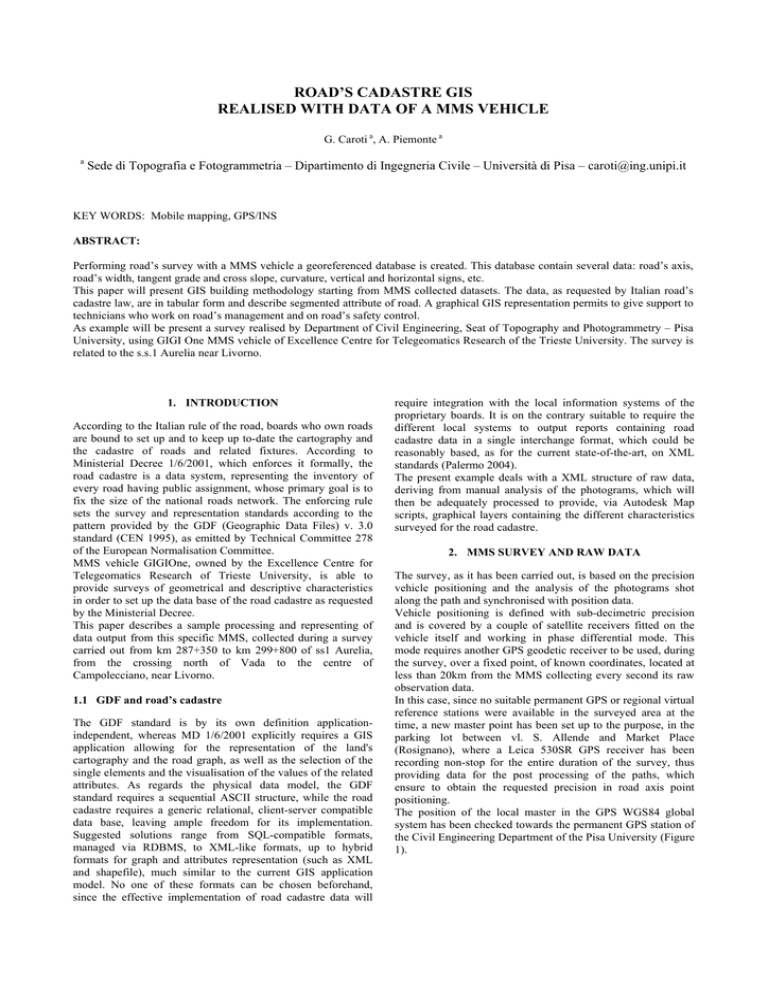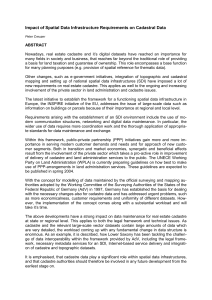ROAD’S CADASTRE GIS REALISED WITH DATA OF A MMS VEHICLE
advertisement

ROAD’S CADASTRE GIS REALISED WITH DATA OF A MMS VEHICLE G. Caroti a, A. Piemonte a a Sede di Topografia e Fotogrammetria – Dipartimento di Ingegneria Civile – Università di Pisa – caroti@ing.unipi.it KEY WORDS: Mobile mapping, GPS/INS ABSTRACT: Performing road’s survey with a MMS vehicle a georeferenced database is created. This database contain several data: road’s axis, road’s width, tangent grade and cross slope, curvature, vertical and horizontal signs, etc. This paper will present GIS building methodology starting from MMS collected datasets. The data, as requested by Italian road’s cadastre law, are in tabular form and describe segmented attribute of road. A graphical GIS representation permits to give support to technicians who work on road’s management and on road’s safety control. As example will be present a survey realised by Department of Civil Engineering, Seat of Topography and Photogrammetry – Pisa University, using GIGI One MMS vehicle of Excellence Centre for Telegeomatics Research of the Trieste University. The survey is related to the s.s.1 Aurelia near Livorno. 1. INTRODUCTION According to the Italian rule of the road, boards who own roads are bound to set up and to keep up to-date the cartography and the cadastre of roads and related fixtures. According to Ministerial Decree 1/6/2001, which enforces it formally, the road cadastre is a data system, representing the inventory of every road having public assignment, whose primary goal is to fix the size of the national roads network. The enforcing rule sets the survey and representation standards according to the pattern provided by the GDF (Geographic Data Files) v. 3.0 standard (CEN 1995), as emitted by Technical Committee 278 of the European Normalisation Committee. MMS vehicle GIGIOne, owned by the Excellence Centre for Telegeomatics Research of Trieste University, is able to provide surveys of geometrical and descriptive characteristics in order to set up the data base of the road cadastre as requested by the Ministerial Decree. This paper describes a sample processing and representing of data output from this specific MMS, collected during a survey carried out from km 287+350 to km 299+800 of ss1 Aurelia, from the crossing north of Vada to the centre of Campolecciano, near Livorno. 1.1 GDF and road’s cadastre The GDF standard is by its own definition applicationindependent, whereas MD 1/6/2001 explicitly requires a GIS application allowing for the representation of the land's cartography and the road graph, as well as the selection of the single elements and the visualisation of the values of the related attributes. As regards the physical data model, the GDF standard requires a sequential ASCII structure, while the road cadastre requires a generic relational, client-server compatible data base, leaving ample freedom for its implementation. Suggested solutions range from SQL-compatible formats, managed via RDBMS, to XML-like formats, up to hybrid formats for graph and attributes representation (such as XML and shapefile), much similar to the current GIS application model. No one of these formats can be chosen beforehand, since the effective implementation of road cadastre data will require integration with the local information systems of the proprietary boards. It is on the contrary suitable to require the different local systems to output reports containing road cadastre data in a single interchange format, which could be reasonably based, as for the current state-of-the-art, on XML standards (Palermo 2004). The present example deals with a XML structure of raw data, deriving from manual analysis of the photograms, which will then be adequately processed to provide, via Autodesk Map scripts, graphical layers containing the different characteristics surveyed for the road cadastre. 2. MMS SURVEY AND RAW DATA The survey, as it has been carried out, is based on the precision vehicle positioning and the analysis of the photograms shot along the path and synchronised with position data. Vehicle positioning is defined with sub-decimetric precision and is covered by a couple of satellite receivers fitted on the vehicle itself and working in phase differential mode. This mode requires another GPS geodetic receiver to be used, during the survey, over a fixed point, of known coordinates, located at less than 20km from the MMS collecting every second its raw observation data. In this case, since no suitable permanent GPS or regional virtual reference stations were available in the surveyed area at the time, a new master point has been set up to the purpose, in the parking lot between vl. S. Allende and Market Place (Rosignano), where a Leica 530SR GPS receiver has been recording non-stop for the entire duration of the survey, thus providing data for the post processing of the paths, which ensure to obtain the requested precision in road axis point positioning. The position of the local master in the GPS WGS84 global system has been checked towards the permanent GPS station of the Civil Engineering Department of the Pisa University (Figure 1). Figure 2. XML raw data format. Output data are then batch processed to set up the final data base in compliance to the road cadastre standards. These data are stored in a relational data base where one of the most important tables is the one that collect the entire set of roads segmented attributes. In figure 3 is shown a subset of this kind of table. Figure 1. Survey map overview. Therefore, precision vehicle positioning in the global reference system allows for the determination of the position, for the same reference time, of every hardware component of the MMS, among which particular relevance is held by the digital photo cameras fitted on the front end of the vehicle's roof. These are two Basler A101f, each with a 1300x1030 pixel CCD sensor, of which one works in full colour and is installed, parallel to the vehicle's axis, on the left-hand side, while the other, fitted on the right-hand side, works in B/W and is oriented 45 degrees towards the right. The cameras' mutual position is fixed and known within the vehicle's reference system, and subsequently also in the GPS global reference system; moreover their orientation parameters are known. While performing the surveys, the cameras shoot one photo every second, which, assuming an average speed of 40km/h, result in one photogram every little more than ten meters, which enables the operators to extract all the characteristics of the roadway from the set of pictures. Besides, since the time of each shoot is recorded in the global reference system, each photogram is georeferenced. In addition to qualitative and segmented data (see MD 1/6/2001) resulting from photograms processing, parameters such as grade and cross slope are computed via the processing of data collected by the vehicle's INS. These parameters, along with the curve radius value, will add up to the table of the road axis points. The survey for each path has been performed with the MMS covering the roadway in both directions. Processing of the collected data (GPS, INS, photos etc.) has allowed for the determination of the shape and width of the roadway and the cross slope for each lane; moreover, it has provided information required for the analysis of the vertical and horizontal signalization. The software which enables operators to determine all the required image coordinates has been developed by the Excellence Centre for Telegeomatics Research, owner of the surveying vehicle, using HTML and JavaScript, exploiting the graphical abilities and the data access model built into Internet Explorer v 6.0. Its interface is fine-tuned on the specific requirements of the road cadastre, and input/output data comply with the XML standard. It allows for the observation of objects on the photogram, storage of their coordinates and association of the classification information provided by MD 1/6/2001 (figure 2). Id_dataset 19 19 19 19 19 19 19 19 19 19 Id_line 1 1 1 1 1 1 1 1 1 1 Type 101 102 103 114 201 202 802 803 900 901 From_ 0 0 11 0 0 0 177 347 0 151 To_ Id_source Abs_rel 357 11 176 357 357 357 186 357 8 151 Startpoint Endpoint Dir 0 357 null 0 11 + 11 176 + 0 357 null 0 357 null 0 357 + 177 186 + 347 357 + 0 8 null 151 151 - Value 590 / 590 0 55 2 0 1 1 4 1 -0001 0050 Figure 3. Segmented attribute table. 3. ROAD’S CADASTRE GIS AutodeskMAP scripts, which create layers referring to the different cadastrial codes, have been automatically generated from the table of the segmented data. First of all, the polyline representing the borders of the roadway has been created, starting from its width data (figure 4), on the basis of the coordinates of the axis point and the azimuth value output by the INS, referring to the same distance from start point. This way, a visual analysis of the consistency of the cartographic support on which cadastrial data are input is possible (figure 5). Hence, in case of differences, it is possible to update the cartographic support at the scales used in regional technical maps (1:2000). Figure 4. Software for image analysis and road’s width. Figure 5. Overlap between map and road’s borders layer. Figure 7. Vertical signs data extraction. A standard survey output is the roadway axis, provided as plan coordinate of its points which are both georeferenced and associated to a specific distance from start point. The reference system used by the road cadastre for net positioning, borrowed from the GDF standard, is of the linear type, with curve abscissa. Each position on the network is defined by the code of the element being covered and from the axial range, starting from the initial junction of the element itself. The points on the road axis have been associated with the geometrical parameters of curve radius, cross slope and grade, automatically obtained by raw survey data. The resulting table can then be queried, e.g. to extract geometrically homogeneous road sections, or to isolate those sections that don't comply with design standards as regards road safety. Figure 6 shows the example of a query of a point on the road axis, together with a view of the data table and the layout of the related cross section. In addition, a real-life rendering of the installed signs, via a layer made up by their 'theoretical images' located alongside the props themselves, makes visual investigation of the status quo much easier. As shown in figure 8, horizontal signalization too has been rendered on the map, in order to have a virtual view of the road in the GIS. As regards horizontal and vertical signalization, proximity analyses of vertical crossings signs, horizontal stop and priority and pedestrian crossing signs can also be quite useful. Figure 8. Render of signalization on the map. The paths of the surveying vehicle in the two directions are also included in the GIS (figure 9). Figure 6. Road’s axis with geometric data layer. The layers of horizontal and vertical signalization have then been obtained from the table of the segmented attributes. Viewing these attributes and the related executable queries in a GIS to investigate the amount of advertising posts or the extension of the horizontal signalization can provide an effective aid, for the road network manager, to set up the economic plan for its maintenance. As regards vertical signalization, a layer referring to the planimetric position of the props, in relation with each installed road sign, is available. Figure 9. Path points of vehicle and shot photo frames. From these points it is possible to go back to the archive image shot during the survey, as well as the raw positioning data and roll, pitch, and heading angles. The data base can therefore be updated, after its set up, with characteristics yet to be extracted by the photograms. Ministero delle Infrastrutture e dei Trasporti, Ispettorato generale per la circolazione e la sicurezza stradale, 2002. D.M. 5 novembre 2001 – Norme geometriche e funzionali per la costruzione delle strade. In: G.U. n. 5/2002. Palermo C., 2002. Il Catasto delle Strade. In: Tecnologos n.8. 4. CONCLUSIONS The overview of GIS applications based on data collected for the road cadastre is quite varied: there are different software platforms, as well as different ways of file management. Public agencies managing the road network have pointed out some common requirements, the first of which is the need for user friendly data management applications, capable of being queried in order to extract just the data subsets required by ongoing researches. Besides, these applications should allow for a GUI-based data management, i.e. by clicking on the elements which make up the different layers direct access to the data base should be granted, as well as the ability to perform any required edit/maintenance session via data input masks. The aforementioned requirements are connected to the need for keeping the road cadastre up to date and effective. As in all census and cadastrial operations, it is mandatory to have data structures and management software designed for easy updating, both by specialized engineers working directly on data structure with no need for a particular interface, and by public agencies employees, which do have analytic and management skills, but lack those needed for the management of the digital data base. Along with the classic topographic work of surveying and producing metric and cartographic data, which are required to set up the cadastrial data base, another, as burdensome, job is required, for the set up of convenient GIS interfaces for the management of the data base itself. As regards the sample survey reported in this paper, several results have been passed over to the road network managing boards. First of all, the relational data base of geometrical and descriptive characteristics, compliant to the GDF standard and MD norms, has been set up. During the initial phase, updates of segmented data must be performed directly on the data base tables, since a convenient GUI, enabling even non-experienced users to perform such updates, is still to be fully developed. Moreover, software has been provided for the automatic generation, starting from the data base, of Autodesk Map scripts, which in turn generate the layers of the attributes related to the different cadastrial codes. This way it is possible to obtain, in Autodesk Map as in any other GIS platform, the graphical rendering of the attributes of the segmented data table, which can be queried to aggregate homogeneous data or to extract informations. 5. REFERENCES Palermo C., 2003. A recipe for the Road Cadastre. In: Reports on Geodesy n. 2(65). Manzoni G., Palermo C., 2003. Il catasto delle strade nel progetto pilota della Provincia di Teramo. In: Ondaverde n. 83. Manzoni G., Martinolli S., Pagurut R., Palermo C., Purga A., Sluga T., 2003. Road survey by GIGI status and results. In: Reports on Geodesy n. 2(65). Palermo C., 2003. Notes on development of a road GIS using data collected by a van mounted MMS. In: Reports on Geodesy n. 2(65). Ministero delle Infrastrutture e dei Trasporti, Ispettorato generale per la circolazione e la sicurezza stradale, 2002. D.M. 1 giugno 2001 – Modalità di istituzione e aggiornamento del catasto delle strade ai sensi dell’art. 13, comma 6, del decreto legislativo 30 aprile 1992, n. 285, e successive modificazioni. In: G.U. n. 4/1/ 2002. Comité Européen de Normalisation, 1995. Committee 287, Geopraphic Data Files ver. 3.0. Technical 6. ACKNOWLEDGMENTS The authors are indebt with Prof. Giorgio Manzoni for MMS GIGI One availability and with his collaborator Dr. Giorgio Bolzon for software development support. Collaboration on survey and photo frames elaboration steps of Dr. Andrea Bedini and Geom. Jessica Micheloni (technicians of DIC Pisa) is gratefully acknowledged.





